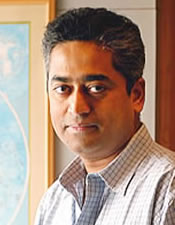
It was Karva Chauth. For 24 hour news channels, it was
yet another opportunity to "dramatise" news. Virtually every channel
(with the sole exception of NDTV) made Karva Chauth their lead story for
the day. Live interviews with women waiting for their husbands to return
home, a sindoor-smeared Sushma Swaraj in a dazzling red sari
being felicitated, a little box at the corner of the screen showing the
"auspicious" moon and an SMS poll being conducted on how people were
celebrating the day. Not once during the day was any channel (again with
NDTV’s admirable exception) willing to add a note of scepticism to the
teledrama that was being enacted in the name of news. Was Karva Chauth a
patriarchal ritual that had no place in modern society? Was it an awful
mix of superstition and ignorance that led women to fast through the
day? Legitimate questions, but none that our channels wanted to raise.
Worst of all, the ritual was being passed off as news. Is it any wonder
then that Ektaa Kapoor may finally have competition from our television
news editors who believe that journalism must look and feel like a
television soap opera?
Two days later the channels were at it again. This time
an old man in a village in Madhya Pradesh claimed that he would die at a
particular time that afternoon. Death in the era of 24 hour channels,
what could be more delicious? So out came the cameras in full force,
covering the "event" live with extended interviews with the man on his
so-called deathbed and endless studio chats with astrologers. The time
came and passed, no one died, but there was not a single note of
scepticism or questioning in the news bulletins.
Stop being self-righteous, argue the channel owners.
We’re all in a battle to capture eyeballs and the fact is, like it or
not, unless there is a little bit of drama that is captured on screen,
the hand that controls the remote will begin to twitch. It could be a
Laloo roadshow one day, a car accident involving a film star’s child the
next and an SMS kiss on the third. Without dramatic content, there is no
news. The other argument is that by showing Karva Chauth in all its hues
or a man’s karmic look into the future we are only capturing an Indian
reality, implying somehow that those who question the manner in which
the ritual was depicted on screen are Anglophile Indians out of touch
with the "real" India.
Both arguments are powerful. There is little doubt that
programmes with heavy doses of overt religiosity sell (witness the
emergence of a number of "devotional" channels that are springing up all
over the place). It is equally true that religious ritual is deeply
ingrained in the Indian mind and Karva Chauth could be seen as a
manifestation of this spirit of ritualism. If news is a mirror to
society then how can it turn its back on a deeply religious society?
Unfortunately, few have pondered to even think that
journalism is more than just an unquestioning record of a news event.
There is more to journalism than just a mike and camera or a pen and
paper. Critical to the process of journalism and news-gathering is the
quality of scepticism. If a certain ritual is seen to be anti-modern
then it is the job, indeed, the duty of the good journalist to question
its continuance. It may seem difficult at times but the journalist must
attempt to draw a line between religion and ritual, between fact and
superstition. Failure to do so is the safest way to create a rather
vacuous society of unthinking Indians.
In the 1980s it was Ramanand Sagar who discovered the
enormous appeal of the Indian epics with his Ramayana, a serial
that sought to create a tele-nation out of religious sentiment. Sagar
may have had his eye on television rating points and little more. But
political groupings like the Vishwa Hindu Parishad were clever enough to
exploit that sentiment to create a millenarian movement aimed at
reviving the glories of a "Hindu" past on the debris of a razed mosque.
The television Ramayana may have dealt with actors playing out
their roles, the Ram Janmabhoomi Rath Yatra affected real life people
with the brazen use of religion for political ends. It revealed how
quickly and dramatically real and reel life could merge.
Today’s news channels are worthy successors to the
Ramanand Sagar success formula, again playing and preying on religious
sentiment. Unfortunately, we forget that Sagar, or an Ektaa Kapoor for
that matter, are fantasy-makers, creating a universe of make-believe and
exaggeration. Journalists live in the real world, where women are
paraded naked in villages, where inter-caste marriage leads to execution
by firman, where policemen rape little girls in broad daylight
and get away with it. It’s easy for an Ektaa Kapoor or a Sagar to
glamourise Karva Chauth or the Ramayana. Why should the
practitioners of journalism fall into the same trap? Why should we have
to glamourise ritual and religion when really our job should be to
demystify it? Why should we spend hour after hour covering a man’s
dubious claim to ending his life? Our job is to relentlessly pursue the
‘real’ news, not some manufactured reality. It isn’t easy in an
increasingly competitive media whirl where journalistic ability is
judged by your Friday morning rating point and not by the quality of the
story. But it has to be done. Else, we might as well apply to become
scriptwriters for some endless soap opera.